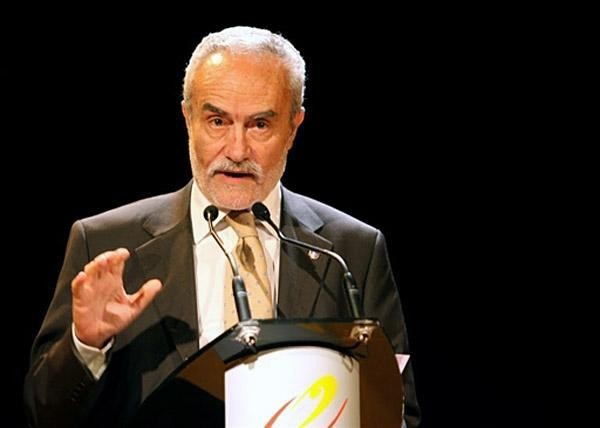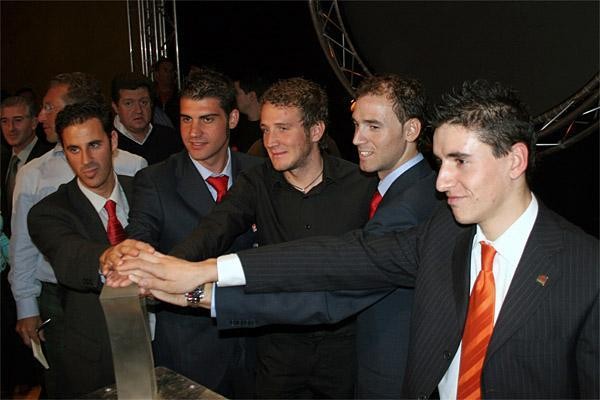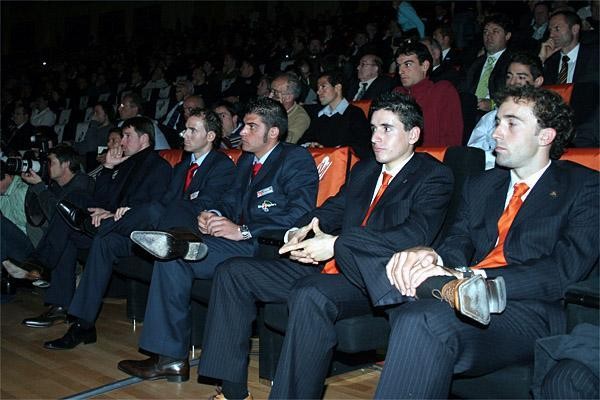Vuelta 2007: Tough opening half and hard finale make for a suspenseful race
Next year's Tour of Spain will adapt an unusual pattern, with the first big day in the mountains...




News feature, December 14, 2006
Next year's Tour of Spain will adapt an unusual pattern, with the first big day in the mountains coming early on and then many of the other principal difficulties taking place in the first half of the event. It should make for nervous, aggressive racing. Cyclingnews' Shane Stokes was at Wednesday's launch in Madrid.
As official race song, Nena Daconte's infectious 'En Qué Estrella Estará" was played many times a day during this year's Tour of Spain. On Wednesday, the organisers continued that theme by launching next year's event under the title "El Sueño de Las Estrellas" or, in English, the Dream of the Stars. Ongoing tensions with the UCI plus suggestions that the Spanish Tour could end up being reduced in length have perhaps been part of this push to underline the idea that this race is an important target for the big names in the sport. Hence the catchy slogan. But whatever the reason, Unipublic appears to have done more than enough to ensure an exciting contest next year.
The general feedback from the riders at the launch was that the 2007 edition is similar to, or perhaps a little easier than the 2006 race. What makes it interesting, though, is that many of the hard stages come very soon after the start, with three summit finishes inside the first ten days. The route settles down for a while but then gets more competitive near the end, making it likely to be a very open, unpredictable tour.
Former Australian professional Alan Peiper perhaps summed it up best when he gave his judgment to Cyclingnews shortly after the launch in Madrid's Palacio Municipal de Congresos. "It is a pretty hard course but what I think is going to be really difficult is that after four days you do [Lago de] Covadonga, then race across the top of the country before you start to drop down south," he stated. "From here (after stage 10) there are only one or two hard days so in the last ten days, the team that is leading is going to have to do a hell of a lot of defensive work.
"What all that means is that you are going to have to have a team which is really collectively-strong in order to defend right the way to Madrid. Okay, there is going to be a time trial at the end and there are one to two mountain-top finishes in between, but there is nothing day after day that can really crack the overall guys. I think it is going to be really interesting as a result… it is not going to be a sprint festival, that's for sure!"
Wednesday's launch got off to a visually impressive start due to the spectacular backdrop in the auditorium housing the function. A link with the stars slogan was underlined through three giant screens bearing lunar and night-sky images, with the atmosphere being boosted by the playing of cricket sounds typical of after-dusk moments.
Get The Leadout Newsletter
The latest race content, interviews, features, reviews and expert buying guides, direct to your inbox!
Up front, the prize seats on the left hand side were held by riders such as runner-up Alejandro Valverde, Tour de France star Oscar Pereiro (both Caisse d'Epargne), 2005 race winner Denis Menchov (Rabobank), Jose Angel Marchante (Saunier Duval) plus Euskaltel's Igor Anton and Inigo Landaluze. However, in spite of the billing as this being a race for the stars, podium finishers Alexandre Vinokourov and Andrey Kashechkin (Astana) plus fourth-placed rider Carlos Sastre (CSC) were all absent.
A sign of lower interest in the race? Probably not, but rather most likely a reflection of the fact that many teams and riders are taking part in training camps at the moment. The off season is getting shorter and shorter, after all, and a mid-December slot for the Vuelta launch makes it difficult to ensure a full house. Still, the organisers did put in a big effort to ensure a glitzy, smooth running presentation.
Once everyone settled down into their seats the screens changed from the astral backdrop to show clips from this year's race. The major battles and characters of the 06 Vuelta were depicted, along with constantly changing, deftly-edited music. This ran for almost ten minutes and then the focus shifted once again in order to reveal to the important details of next year's Vuelta.
The 2007 route
Pereiro may still waiting to see if he will be crowned Tour de France winner but he has become one of the major stars of Spanish cycling. This popularity has been met by the decision to host the start of the three week event in his home city of Vigo in Galicia, close to the Portuguese border on the west coast of Spain.
A 145 kilometre road race will get things underway there on September 1st, with the lumpy course finding favour over the possible alternatives of a prologue or a team time trial, as was the case this year. Day two takes the riders 150 kilometres from Allariz to Santiago de Compostela, following which a transfer moves the field to the following day's start in Viveiro. The peloton will skirt the northern coast on the 155 kilometre route to Luarca, before another transfer gets the competitors, officials and press to Langreo and the start of what will be an early, but crucially important, day's racing.
The Special Category climb of Lagos de Covadonga played a big part in the 2005 Vuelta, with Eladio Jimenez (Comunidad Valenciana) winning the stage and Denis Menchov managing to stick with Roberto Heras (Liberty Seguros) despite the Spaniard's best efforts to crack him. It's a tough, tough climb and one which normally comes later in the race. But the organisers have decided to stir things up early on with the summit finish coming at the end of stage four.
This early shock is followed the next day with a hilly 155 kilometre leg from Cangas de Onís to Reinosa. It's unlikely to be as decisive, but the three second-cat and one first-cat climbs en route means that aggressive racing is guaranteed. The first week then continues with a 195 kilometre leg from Reinosa to Logroño, a 140 kilometre race from Calahorra to Zaragoza and then a mainly flat 49 kilometre individual time trial from Denominación de Origen Carinena to Zaragoza.
After that, two tough days in the high mountains lie in wait. Sunday September 9t begins in Huesca and traverses a hat-trick of second category climbs before the Special Category, 1,920 metre Estación de Esquí Cerler. The following morning, the field will set out from Benasque, scale two cat two and one cat one ascent before facing yet another Special Category monster, the long climb up to the 2,220 Estación d'Esqui d'Ordino-Arcalís in Andorra.
To summarise: just halfway there to Madrid, but already three summit finishes and a longish time trial.
Act two begins after a welcome rest day on Tuesday September 11. The riders have a long transfer from Andorra down to Oropesa, but if this year's race is anything to go by, this will be done by plane rather than team bus. The southerly direction continues for the next three days, via flat to undulating stages from Algemesí to Hellín (167 km), Hellín to Torre-Pacheco (150 km) and Puerto Lumbreras to Villacarrilo/ Parque Natural de Cazorla, Segura y Las Villas (205 km).
The last of these features one third- plus two second-category climbs, making for a likely battle between breakaway riders and those determined to set things up for a bunch gallop.
After three days of relative calm, the overall contenders will likely move to the fore once again on stage 15's 203 kilometre from Villacarrillo to Granada. The terrain is somewhat deceptive, given that it features two third category climbs plus a first category summit to be followed by just over 20 downhill kilometres to the end of the stage. However despite that finale, Alexandre Vinokourov used a very similar leg to Granada this year to wrest the leader's jersey from Valverde, riding aggressively up that first category climb of Alto de Monachil and then shedding his big rival on the drop to the finish. It was an audacious move but one which netted him the race lead and, ultimately, played a major part in his winning of the Vuelta.
Whoever holds the Maillot Oro that evening faces a nervous few days before the finish in Madrid. Six more stages lie in wait; undulating legs from Jaén to Puertollano (165 km) and Ciudad Real to Talavera de la Reina (180 km), then a tougher one from that town to the spectacular walled city of Ávila. A first category climb comes early on and with the race finale looming on the horizon, anyone with a shout of the race lead will be firing on all cylinders as they try to get a gap.
The final big mountain stage comes one day later. Stage 19 from Ávila to Alto de Abantos is just 138 kilometres in length but a glance at the profile shows it will be a hard day in the saddle; cat three, cat two, cat three, cat one, cat three and then a concluding cat one summit finish at an altitude of 1,650 metres spell problems for anyone who hasn't got his climbing legs on.
After that, there awaits a 25 kilometre time trial, starting and finishing in Collado Villalba, then the 100 kilometre concluding race Rivas Vaciamadrid to the Spanish capital of Madrid. As is the case with other Grand Tours, the final day is by and large a processional one for the overall contenders. There will be countless attacks by those hunting for some last minute glory and/or a stage win, but the rider in the maillot oro will be able to enjoy a pride-swelling, career-boosting final few kilometres in the saddle after a tough three weeks on the road.